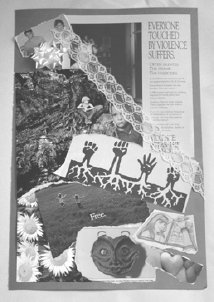
Hiding Pain Behind Prettiness and Play
By Jenny Horsman
Reprinted from Horsman, 2008.
And then I went to collage. I sat with a mountain of very assorted magazines, with six themes in my mind and a list of them beside me and I just kept pulling pictures.... Sometimes I had a concept...and I looked for a picture to illustrate the concept and other times a picture drew me. It wasn't so much that I had a picture that I was looking for until the end when there were some gaps and I know exactly what I was looking for.

Hiding Pain Behind Prettiness and Play
By Jenny Horsman
Reprinted from Horsman, 2008.
[Creating the collages] helped me keep the themes better- as I collected images around, for example "is it too hard to take on [addressing impacts of violence on learning]"-I had all these wild images of sky divers and of rock climbers, all these images of almost impossible acts. As they gelled for me, I had more of a sense of empathy, "Of course it's almost impossible to take on."... It gave me an emotional tenet of the themes. It's like I had content, but once I depicted them I had a much stronger feeling, a much more emotional sense of the meaning of the themes. (personal communication, December 2007)
Chapter 8 includes a description of how Bonnie Soroke (2003) collected data by inviting participants to create sculptures from zippers and other recycled materials. Bonnie also created zipper sculptures to test themes and interpretations of her study:
One way that I responded to interviews and observations was to create sculptures, and then use them to reflect back my perceptions of students' experiences, illustrating their issues and concerns. (p. 49)
Judy Murphy (2008) described how she used photographs to help her make sense of her data about the body and learning. Images are a key way of knowing for Judy: